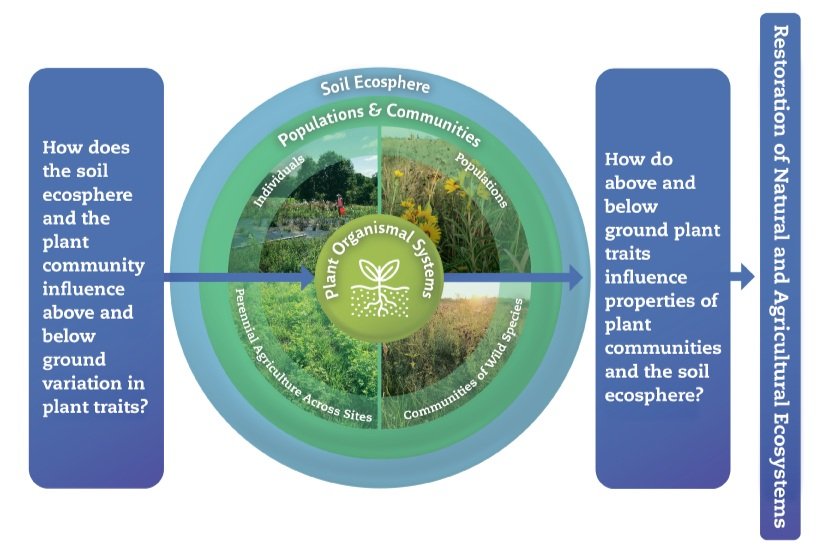
Discovery through integration
New Roots engages scientists from traditionally disparate disciplines to understand how plant organismal systems (including both roots and shoots) relate to one another, and how those relationships influence and are influenced by plant communities and the soil ecosphere. This information can be applied to accelerate breeding efforts (for perennial crops) and selection of suitably biodiverse germplasm (for wild species) to use in efforts to restore natural and agricultural ecosystems.
Facilitating cross-discipline collaboration
A central strength of New Roots is our Expertise Cores, which provide support and guidance on research projects.
These cores are teams of experts knowledgeable in technical aspects required for successful completion of Institute projects. The coordination of these teams creates an integrated Institute firmly positioned to generate a new understanding of plant traits and use them to improve both natural and agricultural ecosystems.
Belowground
phenotyping
Studies belowground structures by quantifying root biomass, imaging excavated roots, and imaging roots in the field.
Data science and analysis
Coordinates Institute data storage, management, analysis, accessibility, and provides statistical and analytical support.
Aboveground phenotyping
Coordinates collection of traits including flowering time, growth rate, leaf size and shape, aboveground biomass, and yield.
Characterizing the m
icrobiome
Analyzes microbes present in the soil including soil/rhizosphere bacteria, fungi, arbuscular mycorrhizal fungi, and oomycetes.
Elemental
profiling
Generates an estimated abundance of 20 elements from a single sample to determine how plants take up and use elements.
Soil structure composition
Characterizes key soil properties including N mineralization, pore structure, total organic C, N, and P, soil texture, and water infiltration.
Synthesis and integration
Determines what statistical approaches and models allow us to understand the link between plant traits, communities, and soil.
Multi-site field logistics
Develops common protocols, notes, and data organization strategies for trait collection and plot maintenance across Institute sites.
Educating, Training, and Outreach
New Roots emphasizes engagement of members across all academic levels. The Institute aims to establish a multi-tiered leadership and mentorship training program that creates a welcoming, engaging, and supportive environment for trainees.
Our long-term goals
-
Understand how plant traits influence and are influenced by plant communities and the soil ecosphere.
-
Integrate across scientific disciplines (plant organismal systems, population and community ecology), partner institutions (public universities, private universities, non-profit research organizations, botanical gardens), and research contexts (natural ecosystems, agricultural ecosystems).
-
Foster collaboration, respect and varied perspectives in communication, conflict resolution, recruitment, training and retention.
-
Recruit and support individuals from a wide range of subdisciplines, career stages, perspectives and training environments across the United States. Train individuals who will continue to restore degraded lands in natural and agricultural ecosystems.
-
Ensure our scientific advances can make a positive impact beyond our own community.









